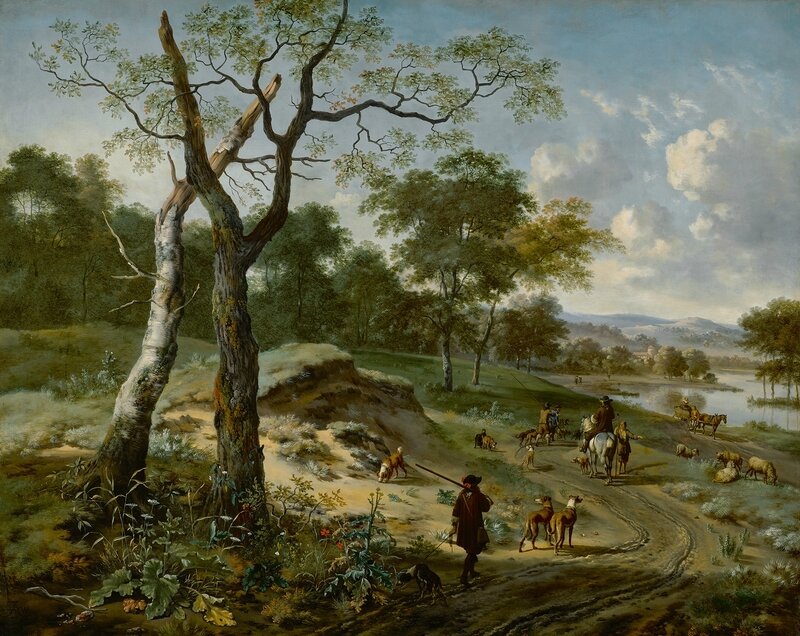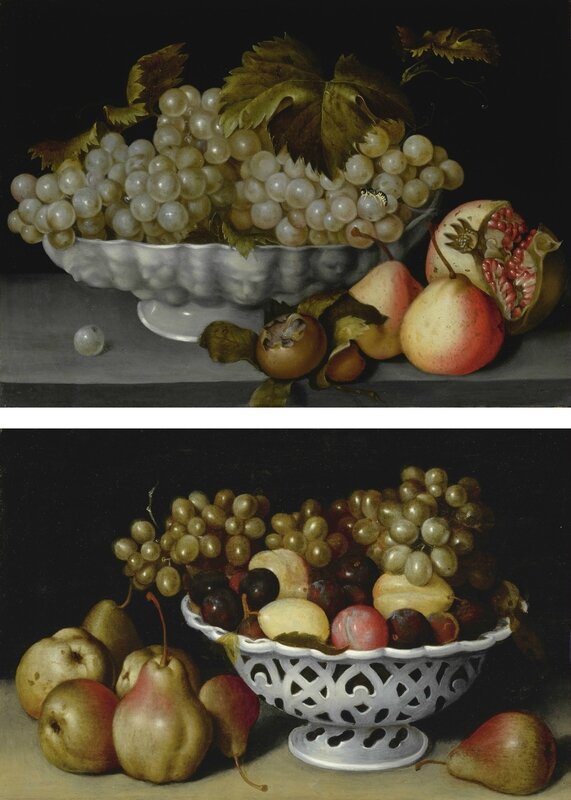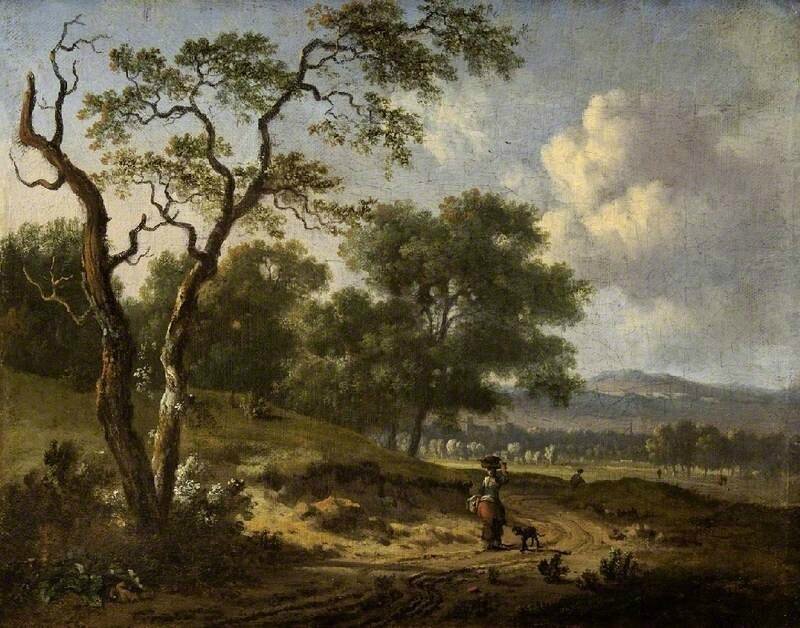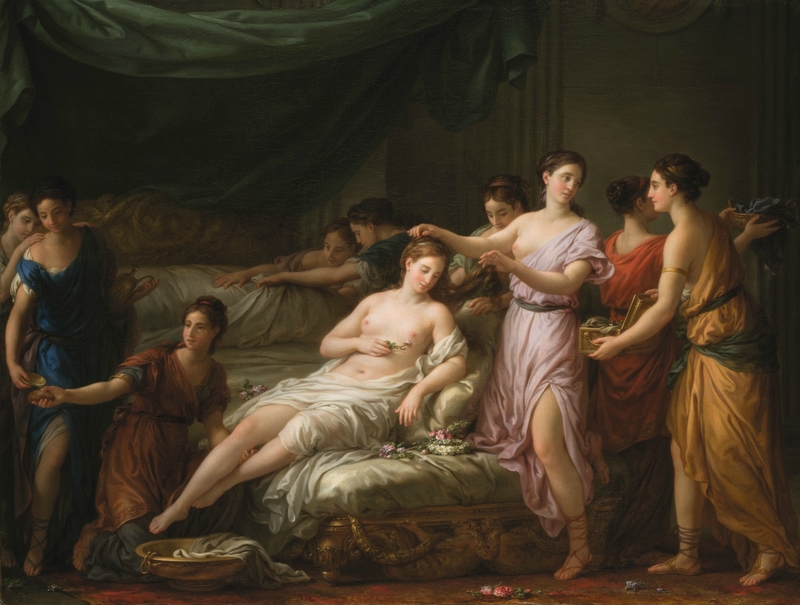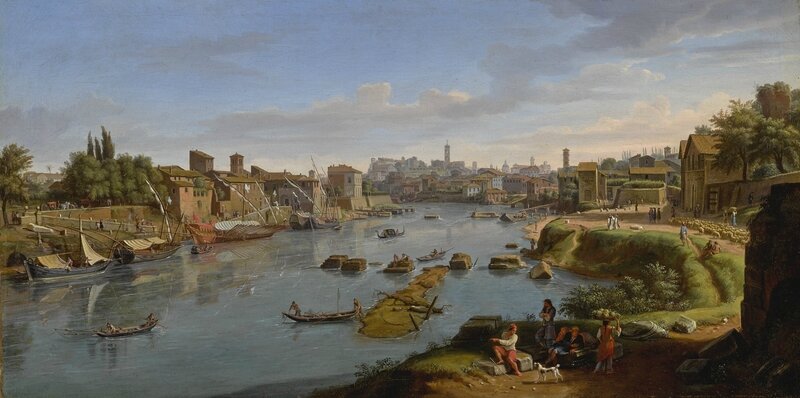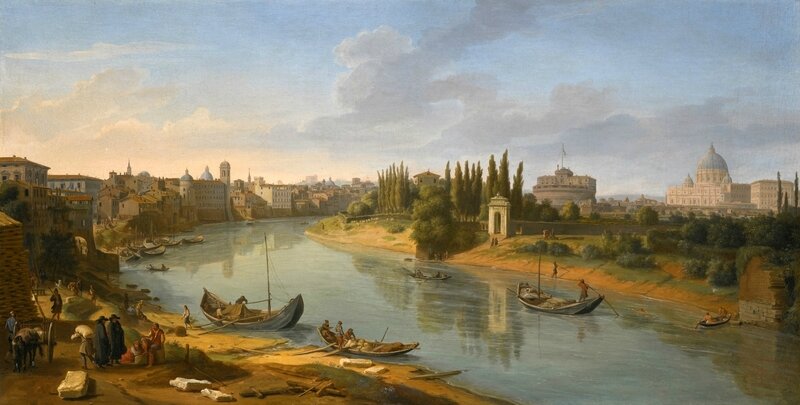![1]()
Lot 45. Jan Wijnants (Haarlem 1632 - 1684 Amsterdam) & Adriaen van de Velde (Amsterdam 1636 - 1672), Wooded Evening Landscape with a Hunter and His Dogs, Another Hunter on Horseback Conversing with a Peasant, a Fishermen and a Falconer Carrying a Hoop of Falcons on a Path, a Wagon and Other Figures by a Lake Beyond. , signed with initials lower left: J. W. Oil on canvas, 59 7/8 by 75 1/4 in.; 152 cm by 191.1 cm. Estimate 2,000,000 — 3,000,000 USD. Courtesy: Sotheby's.
NEW YORK, NY.- Sotheby’s will offer nearly 30 European paintings from the extraordinary private collection of J.E. Safra in the Evening and Day auctions of Master Paintings on 1 & 2 February. Offering a wide range of styles, spanning from the 17th through the 19th centuries, the collection is highlighted by significant works from female artist Fede Galizia, Vanvitelli and Jan Wijnants, among others.
The works will be on public exhibition in Sotheby's New York galleries beginning 26 January, as part of Sotheby’s annual Masters Week exhibitions.
J.E. Safra commented: “I’m thrilled to be offering an eclectic group of Dutch, Flemish, Italian and French paintings once again at Sotheby’s, following the successful sale of my collection of Old Masters and 19th-century paintings in 2011. The two dozen artists represented in the Evening and Day Sales are true masters of their time, and many of these works represent the best of their artistic output.”
Master Paintings Evening Sale
1 February 2018
The Evening Sale property is led by a pair of still-life paintings from the pioneering female painter Fede Galizia (estimate $2/3 million). Celebrated for her still-life painting in Italy and throughout Europe in the first quarter of the 17th century – particularly ones depicting fruit – the present pair is a testament to her sensitive approach to subject matter and acute eye for detail. Galizia’s pared-down compositions rarely depict more than two varieties of fruit and are never overfilled or cluttered, typifying her naturalistic style. At the turn of the 17th-century, still lifes of fruit alone were uncommon in Italy, the earliest known being the Basket of fruit by Caravaggio in the Pinacoteca Ambrosiana, Milan. While it’s possible that Fede was influenced by the intense realism of Caravaggio’s works, her innovative approach to the genre was unique and unparalleled during her lifetime, inspiring generations of artists to follow.
![1]()
Lot 20. Fede Galizia (Milan 1578 - 1630), A Still Life of a Porcelain Bowl of Grapes on a Stone Ledge with a Medlar, Quinces, a Pomegranate and a Wasp; A Still Life of a Porcelain Basket of Plums and Grapes on a Stone Ledge with Pears; a pair, both oil on panel, each: 10 3/4 by 15 1/4 in.; 27.3 by 38.7 cm. Estimate 2,000,000 — 3,000,000 USD. Courtesy: Sotheby's.
Cf. my post: Sotheby's Master Paintings Evening Sale to offer paintings spanning from the 14th - 19th century
Safra’s collection also features a monumental landscape by Jan Wijnants, one of the most important Dutch landscape painters of the second half of the 17th century. Painted in collaboration with Adriaen van de Velde. Wooded Evening Landscape With A Hunter And His Dogs, was inspired by the dunes of Haarlem, the artist’s native city (estimate $2/3 million).
The work is further distinguished by its provenance, having been formerly in the collection of the most important collecting dynasties in modern times. The picture entered the Viennese Rothschild collection by 1873, and thus descended in the family for decades. Displayed in the aptly named ‘Gemäldesaal’ or ‘Museum’ room of Baron Anselm von Rothschild (1803-1874)’s palatial home in Vienna, it hung alongside the family’s most important pictures by the best names from the Dutch Golden Age. When the contents of the family’s palace in Vienna were targeted and seized by Nazi authorities in 1938, the collection – including the present work – was removed to the central depot of the Kunsthistorisches Museum in Vienna, where it was earmarked for Hitler’s planed museum-complex in Linz.
Following the conclusion of the War, the picture was recovered by The Allied Forces’ celebrated Monuments Men from the Nazi storage facilities in the Salt Mines in Alt Aussee before being restituted to Baroness Clarice de Rothschild in 1947. The Wijnants was one of 11 key paintings from the Rothschild collection for which the Kunsthistorisches Museum in Vienna selected in exchange for the grant of a license to export the remainder of the collection to New York. Under the restitution laws introduced in Austria in 1998, the Rothschild family was able to reclaim their collection, and so the Wijnants was returned to the family, and sold at auction in 1999 to the present owner.
![1]()
Lot 45. Jan Wijnants (Haarlem 1632 - 1684 Amsterdam) & Adriaen van de Velde (Amsterdam 1636 - 1672), Wooded Evening Landscape with a Hunter and His Dogs, Another Hunter on Horseback Conversing with a Peasant, a Fishermen and a Falconer Carrying a Hoop of Falcons on a Path, a Wagon and Other Figures by a Lake Beyond. , signed with initials lower left: J. W. Oil on canvas, 59 7/8 by 75 1/4 in.; 152 cm by 191.1 cm. Estimate 2,000,000 — 3,000,000 USD. Courtesy: Sotheby's.
Provenance: Probably Baron Puthon, Vienna;
From whom acquired posthumously by Mr. Netscher;
From whom acquired by De Reus, The Hague, for circa 600 l.;
Baron Anselm von Rothschild, Vienna, by 1873;
Thence by descent to Baron Nathaniel von Rothschild (1836-1905), Vienna, until at least 1903;
Thence by descent to his brother, Baron Albert von Rothschild (1844-1911), 1905;
Thence by descent to Baron Alphonse Mayer von Rothschild (1878-1942), 1911 (inv. no. AR 867);
Confiscated from the above, 13 March 1938 and allocated for the Kunstmuseum Linz;
Munich Central Collecting Point;
Repatriated to the Austrian government, and restituted to the Rothschild family;
Selected as a donation to the Kunsthistorisches Museum, Vienna (inv. 9100), 1947;
Restored to the Rothschild family, March 1999;
Their sale, London, Christie's, 8 July 1999, lot 218;
There acquired by the present collector for $3,600,467.
Exhibited: Vienna, 1873, no. 123;
Vienna, Kunsthistorisches Museum, 1948-1999 (as painted circa 1670).
Literature: Possibly, J. Smith, A catalogue raisonné of the works of the most eminent Dutch painters of the seventeenth century, supplement, London 1842, pp. 747-748, cat. no. 33 (where described in reverse with the nearer huntsman as mounted and with incorrect horizontal measurements);
Inventory of Palais Rothschild, Theresianumgasse, 1903, p. 32, cat. no. 61;
C. Hofstede de Groot, A catalogue raisonné of the works of the most eminent Dutch painters of the seventeenth century based on the work of John Smith, vol. VIII, London 1927, p. 529, cat. no. 438;
Inventory of Palais Rothschild, Theresianumgasse, 1934, p. 187, cat. no. 318;
G. Heinz and F. Klauner, Kunsthistorisches Museum Katalog der Gemäldegalerie 2. Teil: Vlamen, Holländer, Deutsche, Franzosen, Vienna 1963, cat. no. 419;
K. Demus, Katalog der Gemäldegalerie: holländische Meister des 15., 16. und 17. Jahrhunderts, Vienna 1972, p. 110 (noting a verbal query on the attribution by J. Nieuwstraten, who has since, through oral communication, confirmed that he does not remember this query and has absolutely no doubt whatsoever regarding the authenticity of the picture, and indeed believes that the Rothschild picture is "one of the best authentic works by Wijnants");
C. Brandstätter, Die Gemäldegalerie des Kunsthistorischen Museums in Wien: Verzeichnis der Gemälde,Vienna 1991, p. 136, cat. no. 9100, reproduced fig. 523;
"Grande Aste," in Antiquariato, September 1999, p. 44, reproduced;
K. Eisele, Jan Wijnants: ein Niederländischer Maler der Ideallandschaft im Goldenen Jahrhundert, Stuttgart 2000, p. 138, cat. no. 93, reproduced plate XVIII;
F. Kunth, "Anselm von Rothschild, collector," in The Rothschild Archive, Annual Review of the Year April 2001-March 2002, reproduced p. 39;
S. Lillie, Was einmal war. Handbuch der enteigneten Kunstsammlungen Wiens, Vienna 2003, p. 1032, no. 867;
B. Schwarz, Hitlers Museum. Die Fotoalbum Gemäldegalerie Linz: Dokumente zum "Fuehrermuseum", Vienna 2004, p. 112, cat. no IV/10, reproduced p. 237;
F. Kunth, Die Rothschild’schen Gemäldesammlungen in Wien, Vienna 2006, pp. 102, note 191, 108, 230-231;
Note: This splendid large-scale landscape is a masterwork by Jan Wijnants, one of the most important Dutch landscape painters of the second half of the 17th century. Throughout his career, Wijnants drew inspiration for his landscapes from the dunes near Haarlem, where he was born, and where his early development was influenced by Jacob van Ruisdael and Philips Wouwermans. This painting employs one of the artist’s favorite compositional structures, with the left side of the canvas built up with dunes and trees, and a winding path leading into an open panoramic view at right. The staffage in Wijnants' paintings was often added by another artist, in this case by his frequent collaborator Adriaen van de Velde. The son and brother of the marine painters, Willems van de Velde I and II, Adriaen showed promise as a landscape painter and, according to Arnold Houbraken, was sent to Haarlem to study with Wijnants.1 Due to his additional skill at painting both figures and animals, he was often employed to add staffage to landscapes not just by Wijnants, but by other fellow artists such as Ruisdael, Hobbema, van der Heyden and de Moucheron.
Similar compositions by Wijnants can be found in the collection of the National Gallery of Ireland, Dublin (inv. no. 508, 94 by 120 cm.) and the Fitzwilliam Museum, Cambridge (inv. no. 38, 22.2 by 27.9 cm., one of a pair).
![4]()
Jan Wijnants (c.1635–1684), Landscape with a Woman and a Dog, oil on canvas, 22.2 x 27.9 cm. The Fitzwilliam Museum, 38, gift from Augustus Arthur VanSittart, 1876. Photo credit: The Fitzwilliam Museum.
The Rothschild Provenance:
The Rothschild history of this painting by Wijnants is one which highlights the taste for Old Masters by one of the most important collecting dynasties in modern times. The picture was in the collection of Baron Anselm von Rothschild (1803-1874) by 1873. Anselm was the son of Salomon Mayer von Rothschild (1774-1855), founder of the family banking house, and created the K. K. Priv. Österreichische Credit-Anstalt für Handel und Gewerbe, which became the largest bank of the Austro-Hungarian Empire. From the moment of their earliest success, each generation demonstrated a diverse yet equally passionate and astute aptitude for collecting, whose cumulative efforts rival the greatest European noble collections including those of the Habsburgs, Medici, and Bourbons.
This Wijnants hung in Anselm’s palatial home on the Renngasse in Vienna, and specifically in the aptly named ‘Gemäldesaal’ or ‘Museum’ room of the home. It was in this home that the core of the Rothschild family’s Dutch painting collection hung, and it was Anselm who was the first member of the family to truly engage with Dutch pictures on a high level. The core of the collection began with Anselm’s 1842 purchase of the entire collection of the Dutch businessman Klerk de Reus. This acquisition en bloc brought into the family collection important pictures by the best names from the Dutch Golden Age. From this moment Dutch pictures became a priority for Anselm and, indeed, in his posthumous inventory 116 oil paintings were recorded, 93 of which were Dutch old masters.
The picture passed into the collections of Anselm’s sons, first Nathaniel von Rothschild and shortly thereafter to Nathaniel’s brother Albert von Rothschild. Baron Alphonse de Rothschild inherited it from his father Albert, and it was during his period of ownership, within days of the Anschluss in March 1938, that the collection of the Viennese branch of the family was seized by the Nazi authorities. The Wijnants was earmarked for Hitler’s never-realized museum complex in his native Linz. Following the conclusion of the War, the picture was recovered by the American 42nd Division from the Nazi storage facilities in the Salt Mines in Alt Aussee before being restituted to Baroness Clarice de Rothschild, Alphonse’s widow, in 1947. The Wijnants was one of eleven key paintings from the Rothschild collection which the Kunsthistorisches Museum in Vienna selected in exchange for the grant of a license to export the remainder of the collection to New York. The Wijnants hung in the Kunsthistorisches Museum from 1948 until 1999 when it was restituted by the Austrian State to Clarice’s daughter Bettina Looram.
1. See P. Sutton in Masters of 17th-Century Dutch Landscape Painting, exhibition catalogue, Amsterdam 1987, pp. 492 and 523.
Dated to 1777, Women In Classical Dress Attending A Young Bride (estimate $400/600,000) is one of Joseph-Marie Vien’s finest works in the neo-classical style, and the first of four major works painted by the artist during his tenure as Director of the French Academy in Rome. Though history and religious painting dominated his early career, Vien went on to become one of France’s earliest proponents of neo-classicism – catering to the growing demand for antique and classical subjects. Commissioned by the Comte d’Angiviller, Directeur des Bâtiments du Roi, in 1776, the painting was shown at the Paris Salon of 1779, the first and only museum exhibition to include the work.
![2]()
Lot 51. Joseph-Marie Vien (Montpellier 1716 - 1809 Paris), Women In Classical Dress Attending A Young Bride, 1777,signed and dated upper right underneath the medallion: .jos.m.Vien. Romes 1777. Oil on canvas, 39 3/8 by 53 1/8 in.; 100 by 135 cm. Estimate: $400,000-600,000. Courtesy Sotheby’s.
Provenance: Commissioned in 1776 by Charles Claude de Flahaut (1730–1809), Comte d'Angiviller, Directeur des Bâtiments du Roi (who emigrated during the Revolution and his collection seized);
Antoine-Gabriel-Aimé Jourdan;
His sale, Paris, 4 April 1803, lot 56;
There acquired by the sales expert, Paillet, probably for the benefit of Abraham Fontanel (1750-1819);
Galerie Fontanel-Matet, Montpellier;
From whom acquired by Jacques-Joseph de Boussairolles on 30 January 1807;
Anonymous sale, Paris, Hôtel Drouot, 8 April 1908, lot 30 (withdrawn from the sale);
Thence by descent in the de Boussairolles family;
By whom sold, ("La Collection Boussairolles"), Monaco, Sotheby's, 18 June 1992, lot 64;
There acquired by the present collector for $420,813.
Exhibited: Paris, Salon de l'Académie Royale de Peinture, 1779, no. 3.
Literature: Mercure de France, September 1778, p. 250;
Livret du Salon, Paris, 1779, no. 3;
P.-S. Du Pont de Nemours, "Lettres sur les Salons de 1773, 1777 et 1779," addressed by Du Pont de Nemours to Margrave Caroline-Louise of Baden, in Archives de l'Art Français, 2, Paris 1908, p. 68;
P. Chaussard, "Le Pausanias français," Salon de 1806, publié par un observateur impartial, Paris, 1806, p. 54;
P. Chaussard, "Notice sur J.-M. Vien," in Revue Universelle des Arts, 17, 1863, p. 27;
A.-L. Millin, Voyage dans les départements du Midi de la France, Paris 1807-1811, vol. 4, p. 315;
T. Lejeune, Guide théorique et pratique de l'amateur de tableaux, Paris 1863, vol. 1, p. 275;
H. Cozic, "Vien, sa vie et son oeuvre," in Revue de France, 1865, p. 193;
L. Tremblay, "Le peintre Vien, d'après de nouveaux documents," in Revue contemporaine, 30 September 1866, 2nd series, no. 62, p. 267;
F. Aubert, "Joseph-Marie Vien," in Gazette des Beaux-Arts, 1st series, vol. 23, 1867, pp. 306 and 307;
L. De La Roque, Biographie montpelliérenne, Peintres, Sculpteurs et Architectes, Montpellier 1877, p. 53;
A. Lecoy De La Marche, L'Académie de France à Rome, Correspondance inédite de ses directeurs précédée d'une étude historique, Paris 1874, p. 315;
A. De Montaiglon and J. Guiffrey, Correspondance des directeurs de l'Académie de France à Rome..., Paris 1904, vol. 13, pp. 246, 333, 339, 381, 384, 470 and 1905, vol. 14, pp. 9 and 110;
L. Hautecoeur, Rome et la Renaissance de l'antiquitéà la fin du XVIIIe siècle, Paris 1912, p. 154;
H. Mireur, Dictionnaire des Ventes d'Art, Paris 1912, pp. 368-369;
H. Lapauze, Histoire de l'Académie de France à Rome, Paris 1924, vol. 1, p. 360;
J.-P. Alaux, Académie de France à Rome, Ses Directeurs, Ses Pensionnaires, Paris 1933, vol. 1, p. 189;
J. Claparede, "Les peintres du Languedoc Méditérranéen," in La France de toujours - Languedoc méditérranéen et Roussillon d'hier et d'aujourd'hui..., Nice 1947, p. 225;
A. Chevalier, La collection de tableaux de Jacques-Joseph de Boussairolles 1741-1814, mémoire de maîtrise dactylographié, Sorbonne-Paris 1984, vol. 4, p. 38, cat. no. 33, reproduced plate 33;
T.W. Gaehtgens and J. Lugand, Joseph-Marie Vien, Peintre du Roi (1716-1809), Paris 1988, pp. 194-195, cat. no. 238, reproduced plate 238.
Note: Painted by Vien in 1777, Women in classical dress attending a young bride is one of the artist’s finest works in the neo-classical style, and the first of four major works painted by the artist during his tenure as Director of the French Academy in Rome.1 Though history and religious painting dominated his early career, influenced by a particular interest in Italian Baroque painting, Vien went on to become one of the earliest proponents in France of neo-clacissism. The discoveries at Herculaneum and Pompeii had spurred interest in the antique and a demand for classical subjects. Starting in the 1750s, using classical motifs and simpler, more linear compositions, Vien was one of the artists most influential in promoting le goût grec.2 His most famous work in this style is his painting The Seller of Loves, exhibited at the Salon of 1763 (Musée National du Château de Fontainebleau).
Commissioned by the Comte d’Angiviller, Directeur des Bâtiments du Roi, in 1776, Vien began work sometime before September as, on the 11th of that month, the artist wrote to Angiviller that he had already completed a preparatory sketch.3 By the beginning of January 1778, the painting was finished and presented at the Palazzo Mancini, at that time the home of the French Academy in Rome, where it was much admired. Eight months later, it was sent to Paris to be exhibited at the Salon of 1779 and was favorably reviewed by the critics. Shortly before the Paris exhibition, Angiviller wrote to Vien expressing his delight with the painting: “I can hardly express to you how much pleasure it has given me, and to all the artists who were present when the box was opened. Although seen for the first time in my study, decorated as you know by Rubens, Titian, Guido, etc., it did not seem to me to suffer compared to such formidable neighbors. It will take a place in my study deserving of one of the best productions of one of the masters who does the most honor to the French School."4
1. The others are Hector Urging Paris to Take Up Arms, 1779, Musée National du Château de Fontainebleau; The Family of Coriolanus Imploring Him not to Besiege Rome, 1779, Musée Granet, Aix-au-Provence; and Briseis Led from the Tent of Achilles, 1781, Musée des Beaux-Arts, Arras.
2 C.B. Bailey, in The Loves of the Gods, Mythological Painting from Watteau to David, exhibition catalogue, Paris 1991, p. 495.
3. See T. Gaetghen and J. Lugand, under Literature, p. 195, cat. no. 239, possibly identifiable with the sketch that was in the Rosset sale 11 April 1973, lot 301 which is listed in Gaetghen and Lugand on p. 196, cat. no. 240.
4. "J'ai peine à vous exprimer combien de plaisir il m'a fait, ainsi qu'à tous les artistes qui ont assistéà l'ouverture de la caisse. Quoique vu pour la première fois dans mon cabinet, tapissé comme vous le savez de Rubens, de Titien, de Guide, etc..., il ne m'a point paru souffrir d'un voisinage si redoutable. Il tiendra dans mon cabinet la place que mérite une des meilleures productions d'un des maîtres qui font le plus d'honneur à l'Ecole française;" see A. de Montaiglon and J. Guiffrey, Correspondance des directeurs de l'Académie de France à Rome ..., Paris, 1887-1912, Vol XIV, pp. 9 and 110.
Vanvitelli’s View Of The Ripa Grande in Rome, is a beautifully-rendered depiction of the Eternal City's main river port (estimate $800,000/1.2 million). One of the leading fathers of the Italian vedute, the present oil on canvas provides a glimpse into daily life at the end of the 17th century. The right side of the painting shows the Via Marmorata, along which marble from the quarries at Carrara was transported, while on the opposite bank are the main ramps of the port, near the Customs House, with the tower of the church of the Santa Maria in Torre behind it. In the distance is the Church of Santa Maria in Capella, the only building in this group that is still standing to this day. Signed and dated to 1690, it is one of the earliest Italian views by the artist, and one of the finest to remain in private hands.
![7]()
Lot 153. Gaspar van Wittel, called Vanvitelli (Amersfoort 1652/3 - 1736 Rome), Rome, A View Of The Port Of Ripa Grande, signed with initials and dated on the stone lower right: G.W./1690. Oil on canvas, 20 1/4 by 39 3/4 in.; 51.5 by 101 cm. Estimate: $800,000-1,200,000. Courtesy Sotheby’s.
Provenance: Marquis de Masclary, Montpellier (1817-1869);
By descent to Comtesse Joseph de Masclary, Tours, by 1959 and until at least 1966;
By descent to a European nobleman;
By whom anonymously sold, London, Christie's, 4 July 1997, lot 112;
There acquired by the present collector for $1,041,139.
Exhibited: Paris, Galerie Charpentier, Paysages d'Italie, 1947, no. 138;
Tours, Musée des Beaux-Arts, L'Art ancien dans les collections privées de Touraine, 12 July - 20 September 1959, no. 22.
Literature: G. Briganti, Gaspar van Wittel e l'origine della veduta settecentesca, Rome, 1966, p. 213 no. 118, reproduced;
G. Briganti, Artisti in Roma nel Sei e Settecento, Rome 1988, p. 47;
E.A. Safarik & G. Milantoni, Fasto Romano: dipinti, sculture, arredi dei Palazzi di Roma, Rome 1991, p. 126, under cat. no. 33;
L. Salerno, Pittori di vedute in Italia (1580-1830), Rome, 1991, p. 87, under cat. no. 36;
View Paintings of a European Collector, London 1996, p. 16;
G. Briganti, Gaspar van Wittel, Milan 1996, p. 200, cat. no 190, reproduced, and p. 176, under cat. no. 121;
S. Melikian, "Risk is Rising in Old Masters Game," The International Herald Tribune, 12-13 July 1997, p. 9;
S. Reyburn, "Stepping forward a century - the remarkable rise of 'newer' Old Masters," Antiques Trade Gazette, 2 and 9 August 1997, reproduced p. 33;
L. Laureati et. al., Gaspare Vanvitelli e le origini del vedutismo, Rome 2002, p. 69.
Note: Vanvitelli's sweeping view of the Ripa Grande in Rome, an early work by the artist, is a beautifully-rendered depiction of the Eternal City's main river port, giving today's viewers a glimpse into daily life at the end of the 17th century. The right side of the painting shows the Via Marmorata, along which marble from the quarries at Carrara was transported, while on the opposite bank are the main ramps of the port, near the Customs House, with the tower of the church of the Santa Maria in Torre behind it. Beyond this are also the Pamphilij palazzina and the church of Santa Maria in Capella, the only building in this group that remains today. Though seen far in the distance, the Capitol serves as the centerpoint of the composition.
After training in his native Amersfoort, Gaspar Van Wittel, better known by his Italian sobriquet Vanvitelli, spent most of his life in and around Rome after 1675, save for a few trips to the North of Italy, Venice and Naples. He is rightfully considered one of the fathers of the Italian vedute, or panoramic view based on a real place. His combination of faithful description of his environs, in part based on the Northern tradition, with anecdotal quotidian events, was hugely successful. Religious sites and antique ruins were often replaced by views never before depicted which showed the reality of modern Rome; everyday places or ancient sites which were still in use, such as the Ripa Grande, seen here, provided the perfect setting. Vanvitelli's inimitable sense of the warm Italian sunlight added a further allure and grand romanticism to these scenes of daily life.
There are two other versions of this composition in oil recorded, though unlike the present painting neither of them are signed or dated. The first, in the Accademia di San Luca, Rome, is slightly smaller and has different staffage.1 The second, in a private collection, Rome, is larger and composed in a slightly taller format; it not only has different staffage but also includes a large tree on the right side in the foreground.2 Vanvitelli also painted a version in tempera on parchment which is in the Colonna Collection, Rome.3
The present painting, signed and dated 1690, was once accompanied by a pendant view of The River Tiber at the Porto della Legna, Rome, now in a private collection, London (fig. 1).4 The pair remained together in the Masclary collection, but the Porto della Legna appeared on the London art market on its own in 1989.
![8]()
Gaspar Van Wittel, called Vanvitelli, The River Tiber at the Porto della Legna, Rome. Private Collection, London.
1. See Briganti 1996 under Literature, p. 200, cat. no. 191, reproduced p. 201.
2. Ibid., p. 200, cat. no. 193, reproduced p. 201.
3. Ibid., p. 200, cat. no. 192.
4. Ibid., p. 176, cat. no. 121, reproduced p. 177.
Master Paintings and Sculpture Day Sale
2 February 2018
The Day Sale property is highlighted by Gerrit van Honthorst’s playful genre scene, The Flea Hunt (estimate $250/350,000). Credited for introducing the theme of the flea hunt into Netherlandish painting, here the artist depicts the procuress helping the smiling, half-naked woman search for fleas on her clothing, all lit by quintessential candlelight.
![5]()
Lot 146. Gerrit van Honthorst (Utrecht 1590 - 1656), The Flea Hunt, indistinctly signed and dated lower left, oil on canvas, 43 1/4 by 35 1/4 in; 110 by 89.5 cm. Estimate: $250,000-350,000. Courtesy Sotheby’s.
Provenance: Probably Jan Willem Frank, The Hague;
His sale, The Hague, Jan Willem Frank, 5 April 1762, lot 46;
H.M. van Straaten, The Hague;
His sale, The Hague, Van Marle & Bignell, 7 March 1944, lot 67;
With Richard Knight, London;
With Trafalgar Galleries, London;
Anonymous sale ("Property of a European Private Collector"), London, Christie's, 4 July 1997, lot 26;
Where purchased by the present collector for $262,181.
Exhibited: London, Royal Academy, Trafalgar Galleries at the Royal Academy III, 1983, no. 26.
Literature: G. Hoet (P . Terwesten ed.), Catalogus of Naamlyst van Schilderijen..., The Hague 1770, p. 248;
J.R. Judson, Gerrit van Honthorst, The Hague 1959, p. 236, no. 178c (as a copy);
H. Braun, Gerard und Willem van Honthorst, Ph.D., diss., University of Göttingen, 1966, p. 335, no. 5 (as doubtful);
B. Nicolson, The International Caravaggesque Movement, Oxford 1979, pp. 61 and 230;
J. Judson, "New Light on Honthorst", Hendrick ter Brugghen und die Nachfolger Caravaggios in Holland, Braunschweig 1988, p. 113;
Royal Academy, Trafalgar Galleries III, London 1983, pp. 66-9, cat. no. 26, reproduced in color;
B. Nicolson, Caravaggism in Europe, Oxford 1979, (ed. L. Vertova) Turin 1990, vol. I, p. 127, reproduced vol. III, plate 1254;
J. Judson and R. Ekkart, Gerrit van Honthorst, Doornspijk 1999, pp. 199-200, cat. no. 258, reproduced plate. 149 (as a workshop copy after a lost original).
Note: Wayne Franits has recently examined this candlelit Flea Hunt in the original and considers it a characteristic work by Honthorst, datable to circa 1623-25. Though Judson and Ekkart list this work as a workshop replica after a lost original (see Literature), it is clear that they had not examined the painting when it was sold as autograph shortly before the publishing of their 1999 monograph, given the sale's omission from that book. That a lost original separate to the present canvas actually exists remains unclear, and barring direct knowledge of another autograph extant example, this painting should be considered the only known authentic version.1
Honthorst introduced the theme of the flea hunt into Netherlandish painting. As with so many of Honthorst's genre scenes, an allusion to promiscuity and general playfulness is used, though here it is more directly referenced through the use of the flea hunt theme. From antiquity, the flea has been used as a symbol for sex owing to its proclivity to sucking blood from its targets. Writers as early as Aristotle, Pliny and Ovid, and continuing on to Honthorst's contemporaries John Donne, Peter Woodhouse and Christopher Marlowe, all wrote on the intimate and intense associations of the flea with sex.2 Honthorst eliminates any subtle innuendo here as he depicts the procuress helping the smiling, half naked woman search for fleas on her clothing, all lit by Honthorst's quintessential candlelight. Honthorst treated the subject in another painting, signed and dated 1628 (see fig. 1; The Dayton Art Institute, Ohio) which includes two peeping voyeurs in the background of the scene, yet another aid to the viewer in these otherwise not so subtle metaphors.
![6]()
Gerard van Honthorst (1592-1656), The Flea Hunt, 1621, oil on canvas, The Dayton Art Institute
Judson/Ekkart illustrate (cat. D47, fig. 148) a pen, wash, and chalk drawing of a similar composition (Museum der bildenden Künste, Leipzig, inv. no. N.I. 436) that they argue served as the inspiration for the present composition. That drawing likely repeats a Magdalen in Ecstasy, considered a lost original by Caravaggio, which is known in numerous painted versions by Lodovicus Finsonius (Musée des beaux-arts, Marseilles) and Wybrand de Geest, (Don Santiago Alorda collection, Barcelona).
We are grateful to Wayne Franits, Professor of Art History at Syracuse University, for his assistance in the cataloguing of this lot.
1. What appears to be a different painting to the present work, though whose autograph status is unknown, was possibly sold Fa. E. Kahlert & Son & Others sale, Berlin, H.W. Lange, 18-20 June 1940, lot 24. That picture is described as being signed in monogram upper right, and is of different dimensions to the present work.
2. J.R. Judson and R. Ekkart, under Literature, p. 199. John Donne's poem The Flea is one of the better known modern literary sources.





















